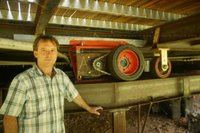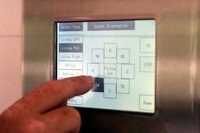
 Talk about energy efficient!
Talk about energy efficient!
Built largely of glass and steel, the house is powered by an electric motor and has some interesting abilities not normally on offer with a conventional home – if you’re keen to soak up some rays, you can program the room you’re in to follow the sun. The maximum speed of the house is one revolution every thirty minutes, a speed offering a kaleidoscope-like usage of ambient light. “Living in the house has been where we’ve learned the most – until you experience that nature’s cavalcade of lights between sunset, morning, evening and then dusk, you can’t fully visualise what’s possible. This is a unique solution for people who want to appreciate where they live and I suspect there are many rewards in the design of rotating homes that we’re yet to discover. And even when we’re at our tenth or one hundredth home, we’ll still be learning things. Some aspects of the view have naturally become favourites says Everingham. “We always turn the living room towards the river at night, and I’ve found I’m more interested in working with a particular view than chasing the sun, so I’ll move the house to where I want it and then let it sit. Given the interest the project has generated within Australia, Luke will be building more rotating homes. “I have looked at what’s required to build rotating homes and I have realised that the best way for me to move forward is to find a national and perhaps international partners to work with,” says Everingham.
Given the interest the project has generated within Australia, Luke will be building more rotating homes. “I have looked at what’s required to build rotating homes and I have realised that the best way for me to move forward is to find a national and perhaps international partners to work with,” says Everingham.
“If you started from scratch, it’d cost a million dollars Australian to build one and you’d be hard pressed to know as much as we knew about the process at that point, let alone what we can add having lived in the house and seen the possibilities of what is possible in the future.”
via gizmodo/gizmag
From the design studio of joel pirela, comes a curated collection of modern architecture, home accessories and current design trends.























